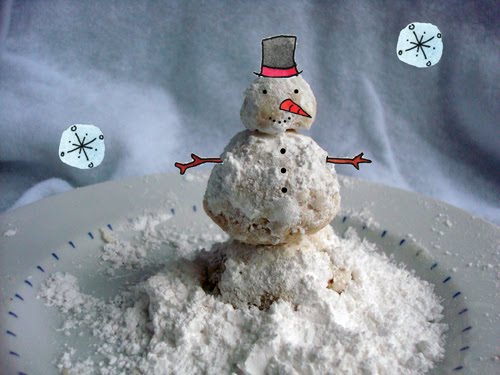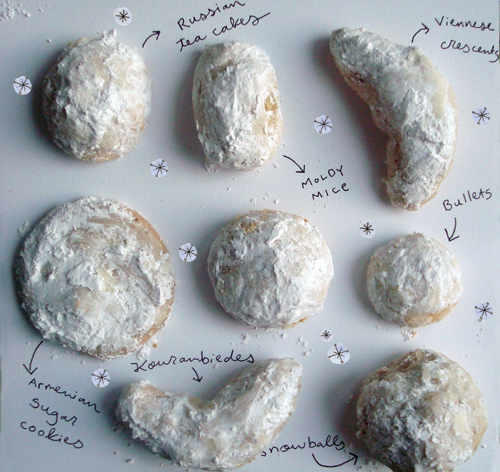
Snowballs. Russian Tea Cakes. Greek Kourambiedes. Bullets. Mexican Wedding Cakes. Viennese Crescents. Moldy Mice. Armenian Sugar Cookies. What does this international sampler of cookies have in common? Quite a bit, it seems--they are just a few (I've counted over 20!) of the countless riffs on the same basic cookie, comprised of butter and (usually) ground nuts, a melt-in-your mouth treat which is liberally coated in confectioners' sugar and seems to be a mainstay in so many special occasions.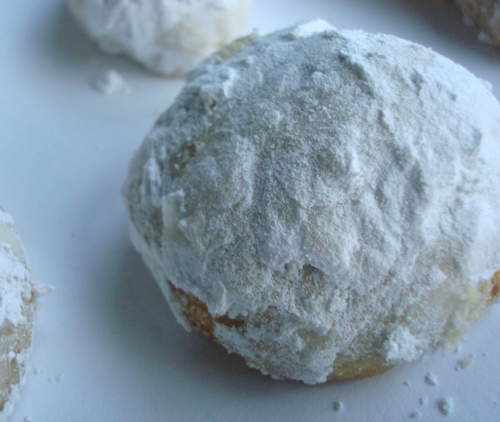
So what gives? I took it upon myself to learn more about this cookie, ultimately applying the knowledge in the sweetest way possible for the December Foodbuzz 24, 24, 24 project: by taste-testing seven different batches of these international treats with a group of friends and reporting not only on the intellectual findings, but dishing on the goods as well.
But first, a little background. What's up with this cookie? Foodtimeline.org offers up the 411:
According to several food history sources and cookbooks...these are a universal holiday cookie-type treat. This means this recipe is not necessarily connected to any one specific country. It is connected with the tradition of saving rich and expensive food (the richest butter, finest sugar, choicest nuts) for special occasions.Of course, that having been said, the cookies do perhaps take their root from the Middle East:
Food historians trace the history of these cookies and cakes to Medieval Arab cuisine, which was rich in sugar. Small sugar cakes with nuts (most often almonds) and spices were known to these cooks and quickly adopted by the Europeans. This sweet culinary tradition was imported by the Moors to Spain, diffused and assimilated throughout Europe, then introduced to the New World by 16th century explorers. Sugar cookies, as we know them today, made their appearance in th 17th century. About sugar. Recipes called Mexican wedding cakes descend from this tradition. They first appear in American cookbooks in the 1950s.
See? I bet you're feeling smarter already. And now, Let it snow confectioners' sugar:Snowballs
About the cookie: This is probably the most famous American version of the cookie--its name seems to stem from their appearance after being rolled in confectioners' sugar. The first mention I could find was a 1939 article in the Chicago Tribune, where it says "don't wait for signs of snow to make these frosty-looking snowball cookies, for they're good in any season". Regional variations will call for filberts, almonds, walnuts, or pecans.
Tasting notes: I made the standard-issue version not unlike the ones I grew up with. These ones, made with walnuts, tasted nostalgic, but didn't necessarily separate themselves from the crowd. But still--they were a delight to eat.
Snowball Recipe
Ingredients
- 2 cups sifted flour
- 1/4 tsp. baking powder
- 1/4 tsp. salt
- 1 cup butter, softened
- 1/2 cup confectioners sugar
- 1-1/2 cups chopped walnuts
- 1-lb. confectioners sugar to roll cookies in
- Sift flour, baking powder, and salt. Mix butter with sugar until very light and fluffy. Mix in flour mixture. Stir in walnuts. Refrigerate until easy to handle.
- Make balls in the palm of your hand by tablespoons. Place on a lightly greased cookie sheet, and bake in a 350 degree F. oven until golden brown, being careful bottoms do not burn.
- Place confectioners sugar in a large bowl. Take cookies from oven and gently put into bowl. Carefully, they are hot, toss cookies in sugar until they are coated.
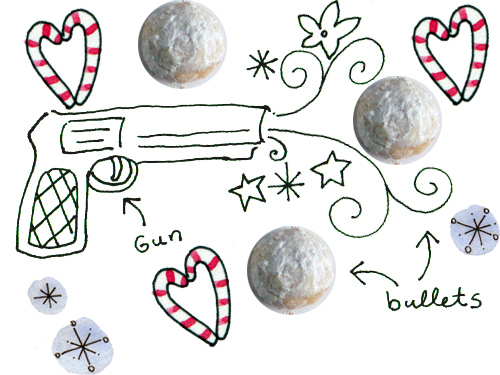
Bullets
About the cookie: These cookies are closely related to the snowball--in fact, I might even surmise that they are a regional version of them, based on the fact that some snowball recipes list a possible variation as using macadamia nuts. However, these ones intrigued me: in the leadup to the recipe, the writer notes that "when we were growing up, my sister Tammie rated these her favorite cookie".
Tasting Notes: Clearly sister Tammie knew what she was talking about. These cookies are the absolute lap of luxury. Flavorwise, they couldn't be more rich: the already buttery-tasting macadamia nuts pair perfectly with this buttery cookie, and they really do just crumble in your mouth. Yes, macadamias are expensive--but this one is worth the splurge. These were one of the top two cookies tasted.
Bullets Recipe
Adapted from Cookies by Natalie Hartanov Haughton
Ingredients
- 1/2 cup butter, at room temperature
- 2 tablespoons granulated sugar
- 1 teaspoon vanilla extract
- 1 cup flour
- 1 cup chopped macadamia nuts
- confectioners' sugar
Preheat oven to 350. In a medium bowl, beat together butter, granulated sugar and vanilla until creamy. Add flour, beating until well blended. If necessary, work with fingers until dough holds together. Blend in nuts. Shape into one-inch balls. Place 2 inches apart on an ungreased cookie sheet. Bake 15-17 minutes, or until bottoms are golden. Remove cookie sheets; cool on racks. After they have cooled for about 30 minutes, roll in confectioners' sugar, coating completely. Makes 30.
- - - - - - - - - - - -


Greek Kourambiedes (or Kourabiethes)
About the cookie: On Whipped, the site where I found this recipe, it says "in the bakeries of Greece, the Kourabiethes are piled up high and deep and look like a mound of little snowballs. My trusty, old-school Greek cookbook reads, 'Kourabiethes are the national cookies of the Greeks for Christmas and New Year’s Day.'
Tasting Notes: True to Whipped's word, these are truly "Greek little balls of heaven". The rosewater adds a certain je ne sais quoi to the cookies, giving them a unique flavor. I shaped some of these into crescents as well.
Greek Kourabiethes Recipe
Only slightly adapted from the recipe on Whipped
Ingredients
- 1 cup unsalted butter
- about 2 cups of confectioners' sugar
- 1 egg yolk
- 1 T brandy
- 2 1/2 cups flour
- 1/8 teaspoon baking powder
- rose water
- 1/2 cup finely chopped almonds
Directions
Preheat oven to 350 degrees. Mix butter and 1 cup sugar until very light and fluffy. Stir in egg yolk and brandy. Mix sifted flour and baking powder in a separate bowl. Mix in the flour and baking powder a little at a time until dough no longer sticks to your fingers. Mix in almonds while mixing in flour, accomodating for the extra ingredient and not letting the cookies get too dry. Knead well until dough is smooth and can easily be rolled; shape into balls or crescents--follow your bliss. Place on parchment paper on a baking sheet. Bake for about 15-20 minutes or until very light brown. While still warm, brush very lightly with orange flower or rose water. Roll in confectioner’s sugar and set on a tray or plate. Use the remaining sugar to sift over top until well covered.
- - - - - - - - - - - -

Mexican Wedding Cakes
About the cookie: Per Foodtimeline.org,
The cookie is old, the name is new. Food historians place the first recipes named "Mexican wedding cakes" in the 1950s. Why the name? Our books and databases offer no explanations. Perhaps timing is everything? Culinary evidence confirms Mexican wedding cakes are almost identical to Russian Tea Cakes. During the 1950s and 1960s relations between Russia and the United States were strained. It is possible the Cold War provided the impetus for renaming this popular cookie. Coincidentally...this period saw the mainstreaming of TexMex cuisine into American culture.Tasting Notes: What set these cookies apart was the addition of cinnamon--they added a spicy holiday flair to the cookies and really set them apart from the rest. As you can see by the photo, even pugs couldn't avoid the holiday charm of these cookies.
Mexican Wedding Cakes Recipe
Ingredients
- 1 cup (2 sticks) butter, room temperature
- 2 cups powdered sugar
- 2 teaspoons vanilla extract
- 2 cups all purpose flour
- 1 cup pecans, toasted, coarsely ground
- 1/8 teaspoon ground cinnamon
Directions
- Using electric mixer, beat butter in large bowl until light and fluffy. Add 1/2 cup powdered sugar and vanilla; beat until well blended. Beat in flour, then pecans. Divide dough in half; form each half into ball. Wrap separately in plastic; chill until cold, about 30 minutes.
- Preheat oven to 350°F. Whisk remaining 1 1/2 cups powdered sugar and cinnamon in pie dish to blend. Set cinnamon sugar aside.
- Working with half of chilled dough, roll dough by 2 teaspoonfuls between palms into balls. Arrange balls on heavy large baking sheet, spacing 1/2 inch apart. Bake cookies until golden brown on bottom and just pale golden on top, about 18 minutes. Cool cookies 5 minutes on baking sheet. Gently toss warm cookies in cinnamon sugar to coat completely. Transfer coated cookies to rack and cool completely. Repeat procedure with remaining half of dough. (Cookies can be prepared 2 days ahead. Store airtight at room temperature; reserve remaining cinnamon sugar.)
- Sift remaining cinnamon sugar over cookies and serve.
- - - - - - - - - -
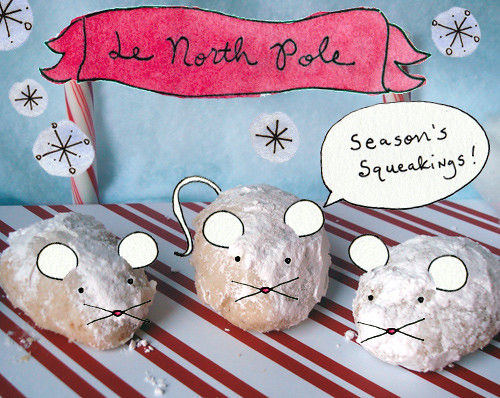
Moldy Mice
About the cookie: This is a rich, buttery pecan cookie smothered in confectioners' sugar, which to the best of my knowledge first cropped up under this name in a 1950 Junior League cookbook entitled Charleston Receipts. What of the name? As you can read on Serious Eats (where you can also find the recipe) I have two theories: first, if you squint really hard at the cookies, they sort of resemble tiny mice covered with mold. Second--my favored theory--is that it is a clever deterrent technique dreamed up by a baker frustrated by their delectable morsels disappearing too quickly.
Tasting Notes: These rich, tender cookies were a big hit: toasting the pecans before baking really added something.
Moldy Mice Recipe
You can find it on Serious Eats!
- - - - - - - - - -
Russian Teacakes
About the cookie: Per foodtimeline.org,
Noble Russian cuisine (along with every other facet of noble life) was influenced by prevailing French customs during the 18th century. Tea was first introduced to Russia in 1618, but the Russian tea ceremony of samovars and sweet cakes was a legacy of Francophile Catherine the Great in the 18th century. It is interesting to note that A Gift to Young Housewives, Elena Molokhovet [1870s popular Russian cookbook] contains plenty of recipes for a variety of small baked goods, none specifically entitled Russian tea cakes. There are, however, several recipes which use similar ingredients.Tasting notes: What can be said? This recipe is a classic.
Russian Teacakes Recipe
Ingredients
- 1 cup butter or margarine, softened
- 1/2 cup powdered sugar
- 1 teaspoon vanilla
- 2 1/4 cups all-purpose flour
- 3/4 cup finely chopped nuts
- 1/4 teaspoon salt
- Powdered sugar
- Heat oven to 400ºF
- Mix butter, 1/2 cup powdered sugar and the vanilla in large bowl. Stir in flour, nuts and salt until dough holds together.
- Shape dough into 1-inch balls. Place about 1 inch apart on ungreased cookie sheet.
- Bake 10 to 12 minutes or until set but not brown. Remove from cookie sheet. Cool slightly on wire rack.
- Roll warm cookies in powdered sugar; cool on wire rack. Roll in powdered sugar again.
- - - - - - - - - - - -
Armenian Sugar Cookies (Shakarishee)
About the cookie: This is a traditional cookie, called shakarishee, which I am told is a commonly served item at weddings or other special occasions.
Tasting Notes: Sweeter than some others, this recipe yielded a cookie that looked more like a drop cookie when baked rather than holding a snowball shape; the nuts were only an accent in this version, but what held true to all of the other recipes was the texture, which was crumbly and dense and delicious. Taster Jasen, who is himself Armenian, commented that "these make me feel like I should be at an Armenian wedding".
Armenian Sugar Cookies Recipe
Adapted from this Shakarishee Recipe
Ingredients
- 2 1/4 cups flour
- 1 3/4 cups sugar
- 1 cup softened butter [unsalted]
- 1 egg yolk
- 1/2 cup finely chopped walnuts
Directions
- In a large bowl, beat together the butter, egg yolk and the sugar until smooth and almost white in color. Add flour and blend well. If you are using the nuts, this is the time to add them in. Shape into small rectangles about 3/4" by 1 1/2".
- Bake on an ungreased cookie sheet and bake for 15-20 minutes or until lightly browned on the sides. Note: The recipe notes that a blanched almond or walnut half can be placed on top of the cookie before baking, but for uniformity I did not add this.
- - - - - - - - - - - -
Viennese Crescents
About the cookie: Well, it seems that Vienna has a bit of a history with delicious crescents--could the shape of this cookie be connected to the other famous crescent from that fair city, the croissant? Read on for Wikipedia's roundup:
Tasting Notes: This is a winner. The almonds paired with almond extract was an idea I got from Cook's Illustrated, and it really did give the cookies a full, almond-y flavor and helped balance out the fact that almonds are a drier nut than some of the more smooth, buttery varieties I had tried in other recipes. These were simply lovely.Fanciful stories of how the kipfel - and so, ultimately, the croissant - was created are culinary legends, at least one going back to the 19th century. These include tales that it was invented in Europe to celebrate the defeat of a Muslim invasion at the decisive Battle of Tours by the Franks in 732, with the shape representing the Islamic crescent;that it was invented in Vienna, Austria in 1683 to celebrate the defeat of the Turks to Polish forces in the Turkish siege of the city, as a reference to the crescents on the Turkish flags, when bakers staying up all night heard the tunneling operation and gave the alarm; tales linking croissants with the kifli and the siege of Buda in 1686; and those detailing Marie Antoinette's hankering after a Polish specialty.
Viennese Crescents Recipe
Makes about 36
- 2 cups all-purpose flour
- 1 cup butter
- 1 cup ground almonds
- 1/2 cup sifted confectioners' sugar
- 1/8 teaspoon salt
- 1 teaspoon vanilla extract
- 1/2 teaspoon almond extract
- 2 cups sifted confectioners' sugar
Directions
- Preheat oven to 350 F.
- In a large mixing bowl, combine flour, butter, nuts, 1/2 cup confectioners' sugar, salt, almond extract, and vanilla. Hand mix until thoroughly blended. Shape dough into a ball; cover and refrigerate for about an hour.
- Remove dough from refrigerator and form into 1 inch balls. Roll each ball into a small roll, 3 inches long. Place rolls 2 inches apart on ungreased cookie sheet, and bend each one to make a crescent shape.
- Bake 15 minutes in the preheated oven, or until set but not brown.
- Let stand 1 minute, then remove from cookie sheets and place on racks to cool. After about 30 minutes, dip cookies in the confectioners' sugar to coat them. If not served right away, dip them again directly before serving to ensure a snowy coating.
- - - - - - - - - -
So, to sum it all up? It was particularly sweet to see how this cookie transcends so many borders: even though our cultures may be very different, we all have some sort of variation of this cookie in common. Regardless of the language you speak or the culture you come from, a cookie made of butter, ground nuts, and coated in confectioners' sugar is a type of equality that is within reach for everyone: easy to make, and completely delicious.

